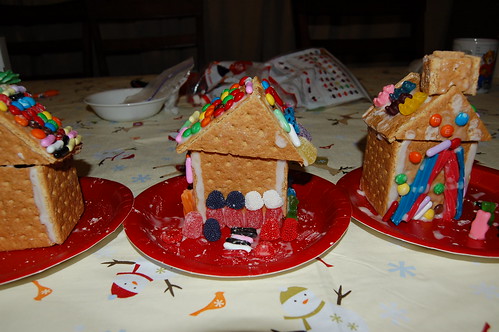The January 2010 Daring Bakers’ challenge was hosted by Lauren of Celiac Teen. Lauren chose Gluten-Free Graham Wafers and Nanaimo Bars as the challenge for the month. The sources she based her recipe on are 101 Cookbooks and www.nanaimo.ca.
Shut up, you hoser!
Lauren’s choice is fitting, considering the imminent 2010 Olympics, hosted in beautiful Vancouver, B.C., just few hundred miles away from my home in Seattle. Am I going to be anywhere near there in February? Heck, no. But I will be watching the coverage down here, and what better local treat to enjoy than these wonderful chocolatey layer bars. For those of you unaware, Nanaimo is a city located on Vancouver Island in the province of British Columbia.
And there is some great history on behind the Nanaimo Bar. If I may quote the always-accurate Wikipedia:
The bar originated in Ladysmith south of Nanaimo in the early 1950s. A local housewife from Cowichan Bay, by the name of Mabel Jenkins, submitted the recipe to the annual Ladysmith and Cowichan Womens Institute Cookbook. This cookbook was sold in the early 1950s in the region as a fundraiser. It made its way throughout the province’s communities by way of household cookery recipes shared by housewives in the 1950s, particularly via company towns. It was sold in many of the coffee shops on Nanaimo’s Commercial Street, and soon became popular. Tourists in the region, especially US tourists on pleasure boats came to refer to these as “Nanaimo Bars”.
But before we get ahead of ourselves, let’s begin with the basics of Lauren’s challenge, namely, the homemade graham wafer (or as we ridiculous Americans like to call graham crackers). Seems to make sense now, until this challenge I did not know this is a North American treat. Loved hearing about the experiences of my global daring baker neighbors who have never seen or heard of a graham cracker, something I’ve taken for granted all my life.
Baking them was fun and simple. Reminded me why I enjoy baking. While Celiac Teen impressed upon us to try the gluten-free version, I opted for the gluten-ful version for cost reasons. I did look for the gluten-free ingredients and was surprised that the local natural foods store did not have all of the flours available in their bulk section, and not even all of them in the packaged section (Really, View Ridge PCC? I am shocked). Total costs of buying the flours packaged was over $15 at Whole Foods and since I had all of the gluten-ful ingredients at home anyway, I made the decision to go gluten.
I didn’t expect the cracker to be so simple to make. I love this recipe because it’s so natural. Most commercially-made graham crackers contain high-fructose corn syrup, something this family strives to avoid. Mine were a little softer than the grocery-store kind, but I kind of like them chewy that way. Works for me.
I must say the dough smelled terrific. Just like honey graham crackers! I loved making that dough. With fair warning from fellow DBs that it was sticky, I was well-prepared. I baked these Saturday, with the plan to make the Nanaimo Bars on Sunday, using crackers that came out a little bit more crunchy.
On Sunday, the husband took the babe with him to his parents and I was given a few hours to myself, some of which I thought I would spend on the bars. Not all of the 5 or so hours, just some. To my surprise, the simple recipe became a decidedly challenging one for me. First, I couldn’t find my square baking pan. I asked the husband who denies knowing its whereabouts. If I find my Calphalon pan under a sink catching a leaky pipe somewhere there will be heck to pay. Though this didn’t really slow me down. No problem, I thought. I’ll be creative and use my silicone muffin pan. That was challenge #1.
Challenge #2 was my desire to reduce the rich/sweetness, especially of the middle icing layer, which was basically icing sugar and butter. Other DBs declared this a decadent treat. My attempt to test a way to reduce the richness of that icing layer turned into a debacle. I got the math wrong or something, and my icing layer would not thicken. And it was lumpy. I hate lumpy. I was very close to throwing my Kitchen-Aid mixer out the window when instead I just left the house. Took a walk. Who knew making a layered bar would be so frustrating. When I returned I decided to turn that middle layer into a vanilla pudding layer and suddenly things looked up.
Because of the consistency of the pudding (kinda soft), I threw the pan into the freezer. My bars became a really great frozen treat. The layers themselves are not has thick as the typical bar, however in an effort to reduce the richness of it, I think I succeeded. I wouldn’t call these “light” by any means (a cup of butter by any other name is still a cup of butter), but definitely a great version for those not into the sweet-sweet treats.
For the bottom layer I traded the ground almonds for pecans, then sprinkled some of those pecans on top. The top layer is your basic semi-sweet chocolate. Yum.
In hindsight, a lot of fun. As always, very thankful for even a few hours of alone time between the kitchen and me, even if we fight a little. You gotta have a little passion in the relationship, right.
Jump for the recipes, download the PDF or visit TheDaringKitchen.com for recipes plus additional baking tips.















